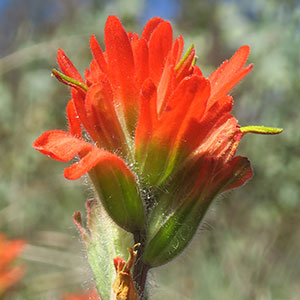Castilleja brevilobata
Castilleja plagiotoma
short-lobed paintbrush
Mojave desert paintbrush, Mojave Indian paintbrush, Mojave paintbrush
solitary or few, erect or ascending, unbranched, sometimes branched, hairs spreading, short, medium, and long, soft, short and medium ones short stipitate-glandular.
several, erect to weakly ascending, often leaning on nearby shrubs, much-branched, often with short, leafy axillary shoots, hairs sparse, spreading, short or long, soft, branched or unbranched, eglandular.
green or ± yellow, lanceolate, elliptic, or oblong to narrowly ovate, 1–2(–2.5) cm, not fleshy, margins plane or wavy, involute, (0–)3–5(–7)-lobed, apex rounded to acute;
lobes ascending to erect, linear to lanceolate, apex rounded to acute.
gray-green or green to purple to ± deep red, linear or linear-lanceolate, 2–5 cm, not fleshy, margins plane to ± wavy, flat or involute, 3–5(–7)-lobed, apex acuminate to acute;
lobes spreading-ascending, sometimes widely so, narrowly linear, apex acute or obtuse.
3–20 × 2–3.5 cm;
bracts proximally greenish to dull brown, distally red, orange-red, or scarlet, sometimes orange or yellow, broadly lanceolate or oblong, (0–)3–5-lobed;
lobes ascending, broadly to narrowly lanceolate, short, arising above mid length, apex acute, obtuse, or rounded.
3–20 × 0.5–1.5 cm;
bracts green throughout, sometimes tinged dull purple, proximal sometimes linear-lanceolate, distal or all bracts oblong, 3–5(–7)-lobed;
lobes spreading to ascending, linear to oblanceolate, short to long, proximal lobes arising near mid length, sometimes wavy-margined, central lobe apex rounded to truncate, lateral ones obtuse to rounded.
straight, 15–24(–26) mm;
tube 12–16 mm;
beak exserted, abaxial lip equal to calyx;
beak adaxially green or ± yellow-green, 7–10 mm, puberulent, stipitate-glandular;
abaxial lip deep green, reduced, rounded, 1–2 mm, 10–25% as long as beak;
teeth incurved to erect, light green, 0.5–1 mm.
straight, 13–20 mm;
tube 5–7 mm;
beak short-exserted, sometimes shorter than abaxial calyx segments, adaxially yellow, rarely greenish, 7–10 mm;
abaxial lip pale green to yellowish, reduced, 0.5–1.5 mm, 7–17% as long as beak;
teeth reduced to apiculations, pale green to yellowish, 0.5–0.8 mm.
green or whitish with green veins, lobes colored as bract lobes or paler, 14–30 mm;
abaxial and adaxial clefts 5.5–8.5 mm, 30–40% of calyx length, deeper than laterals, lateral 1.5–4 mm, 20–25% of calyx length;
lobes oblong to narrowly triangular, apex obtuse to rounded.
light green, cream, or light yellow, often appearing white from dense white-woolly pubescence, 10–18 mm;
abaxial clefts 5–6.5 mm, closed by intertwined hairs and appearing 2 mm deep, adaxial 2.2–4.2 mm, abaxial ca. 25% of calyx length, adaxial ca. 20% of calyx length, shallower (or appearing much shallower), than laterals, lateral 4.6–7.5 mm, ca. 50% of calyx length;
lobes: abaxial segments broad, paddle-shaped, 7 mm, inner surface of abaxial segments densely white-woolly, apex rounded to broadly obtuse, adaxial narrowly triangular, 5 mm, apex acute.
= 24.
Castilleja brevilobata
Castilleja plagiotoma
Castilleja brevilobata is endemic to dry serpentine openings in the Siskiyou Mountains of southwestern Oregon and adjacent California. Although sometimes treated as part of C. applegatei or C. hispida, its morphology does not suggest a close connection with either. This species occasionally hybridizes with C. pruinosa in Del Norte County, California.
(Discussion copyrighted by Flora of North America; reprinted with permission.)
Castilleja plagiotoma is unique in the genus in the structure of its calyces, with the lateral clefts deeper than the median clefts. The relative lengths of the calyx lobes are also unique, with the abaxial lobes exceeding the adaxial lobes by 2–3 mm. The abaxial lobes also bear a dense indument of whitish, branched hairs. The uniformly greenish bracts are uncommon among perennial species of Castilleja. Castilleja plagiotoma is scattered in the western Mojave Desert and the hills adjacent to the southwestern San Joaquin Valley, California. While not of immediate conservation concern, this species is uncommon and increasingly threatened by recreational vehicles, livestock grazing, residential development, and resource extraction.
Castilleja plagiotoma is most often associated with and is likely parasitic on Eriogonum fasciculatum var. polifolium, but it is also often observed with Artemisia tridentata or other species. It is a known larval host plant for the butterfly, Euphydryas editha subsp. erlichii.
(Discussion copyrighted by Flora of North America; reprinted with permission.)


